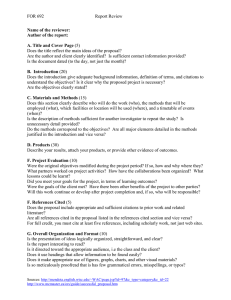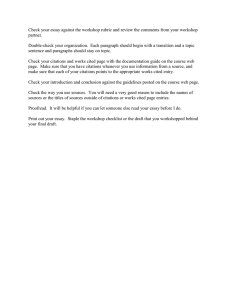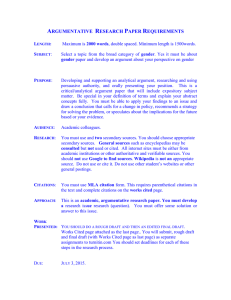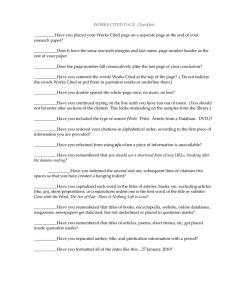Referencing Text Citations
advertisement
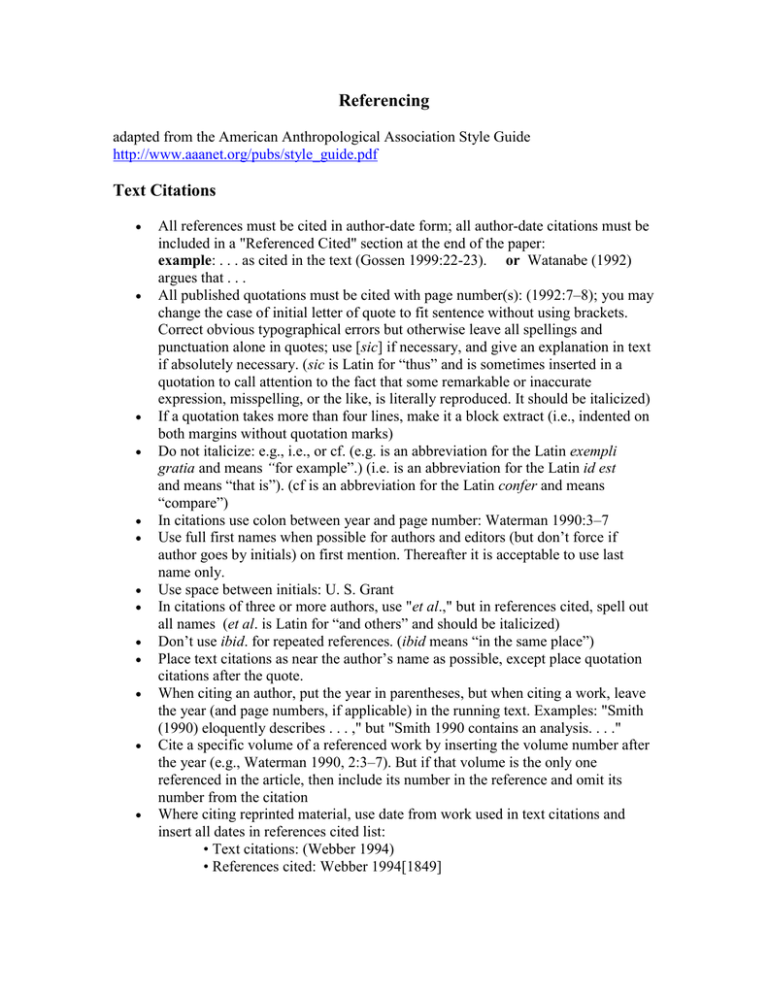
Referencing adapted from the American Anthropological Association Style Guide http://www.aaanet.org/pubs/style_guide.pdf Text Citations All references must be cited in author-date form; all author-date citations must be included in a "Referenced Cited" section at the end of the paper: example: . . . as cited in the text (Gossen 1999:22-23). or Watanabe (1992) argues that . . . All published quotations must be cited with page number(s): (1992:7–8); you may change the case of initial letter of quote to fit sentence without using brackets. Correct obvious typographical errors but otherwise leave all spellings and punctuation alone in quotes; use [sic] if necessary, and give an explanation in text if absolutely necessary. (sic is Latin for “thus” and is sometimes inserted in a quotation to call attention to the fact that some remarkable or inaccurate expression, misspelling, or the like, is literally reproduced. It should be italicized) If a quotation takes more than four lines, make it a block extract (i.e., indented on both margins without quotation marks) Do not italicize: e.g., i.e., or cf. (e.g. is an abbreviation for the Latin exempli gratia and means “for example”.) (i.e. is an abbreviation for the Latin id est and means “that is”). (cf is an abbreviation for the Latin confer and means “compare”) In citations use colon between year and page number: Waterman 1990:3–7 Use full first names when possible for authors and editors (but don’t force if author goes by initials) on first mention. Thereafter it is acceptable to use last name only. Use space between initials: U. S. Grant In citations of three or more authors, use "et al.," but in references cited, spell out all names (et al. is Latin for “and others” and should be italicized) Don’t use ibid. for repeated references. (ibid means “in the same place”) Place text citations as near the author’s name as possible, except place quotation citations after the quote. When citing an author, put the year in parentheses, but when citing a work, leave the year (and page numbers, if applicable) in the running text. Examples: "Smith (1990) eloquently describes . . . ," but "Smith 1990 contains an analysis. . . ." Cite a specific volume of a referenced work by inserting the volume number after the year (e.g., Waterman 1990, 2:3–7). But if that volume is the only one referenced in the article, then include its number in the reference and omit its number from the citation Where citing reprinted material, use date from work used in text citations and insert all dates in references cited list: • Text citations: (Webber 1994) • References cited: Webber 1994[1849] References Cited Examples: The general format is: author’s last name, comma, first name, period. Date of publication. Period. Title of work, period, Place of publication, colon: publisher. Where there are two places of publication for a reference, use only the first’ Single-Author Book: Castles, Stephen. 1990. Here for Good. London: Pluto Press. Coauthored Book: Bonacich, Edna, and John Modell. 1975. The Economic Basis of Ethnic Solidarity: Small Business in the Japanese American Community. Berkeley: University of California Press. Author, with Others: Bonacich, Edna, with Mark Smith and Kathy Hunt. 1999. The Economic Basis of Ethnic Solidarity: Small Business in the Japanese American Community. Berkeley: University of California Press. Multiple References in the Same Year (alphabetize by title): Gallimore, Ronald. 1983a. A Christmas Feast. New York: Oxford University Press. ------------------ 1983b. Holiday Gatherings in the Pacific Northwest. Berkeley: University of California Press. Chapter in Book with Editor(s): Rohlen, Thomas P. 1993. Education: Policies and Prospects. In Koreans in Japan: Ethnic Conflicts and Accommodation. C. Lee and George De Vos, eds. Pp. 182–222. Berkeley: University of California Press. Price, T. Douglas. 1984. Issues in Paleolithic and Mesolithic Research. In Hunting and Animal Exploitation in the Later Paleolithic and Mesolithic of Eurasia. Gail Larsen Peterkin, Harvey M. Bricker, and Paul Mellars, eds. Pp. 241– 244. Archeological Papers of the American Anthropological Association, 4. Arlington, VA: American Anthropological Association. Editor as Author: Diskin, Martin, ed. 1970. Trouble in Our Backyard: Central America in the Eighties. New York: Pantheon Books. Article in Journal: Moll, Luis C. 2000. Writing as Communication: Creating Strategic Learning Environments for Students. Theory into Practice 25(3):202–208. Book in a Series: Bartlett, H. H. 1974. The Labors of the Datoe and Other Essays on the Batak of Asakan (North Sumatra). Michigan Papers on South and Southeast Asia, 15. Ann Arbor: University of Michigan Press. Review: Trueba, Henry T. 1999. Review of Beyond Language: Social and Cultural Factors in Schooling Language Minority Students. Anthropology and Education Quarterly 17:255–259. Report: Kamehameha Schools. 1977. Results of the Minimum Objective System, 1975– 1976. Technical Report, 77. Honolulu: Kamehameha Schools, Kamehameha Elementary Education Program. Ph.D. Dissertation: D’Amato, John. 1989. "We Cool, Tha’s Why": A Study of Personhood and Place in a Class of Hawaiian Second Graders. Ph.D. dissertation, Department of Education, University of Hawaii. Reprint/Translation: van Genep, A. 1960[1908]. The Rites of Passage. Michaela Vizedom and Mari Caffee, trans. Chicago: University of Chicago Press. Subsequent Edition: Gallimore, Ronald. 1960. Qualitative Methods in Research on Teaching. In Handbook of Research on Teaching. 3rd edition. Margaret C. Wittrock, ed. Pp. 119–162. New York: Macmillan. Article in a Newspaper or Popular Magazine: Reinhold, Robert. 2000. Illegal Aliens Hoping to Claim Their Dreams. New York Times, November 3: A1, A10. Personal Communication (including e-mail, listserv, and newsgroup messages): Should be cited in text, with specific date, but not in references. Example: "Horace Smith claims (letter to author, July 12, 1993) that. . . ." Internet Document: Use this format for public Internet documents with URLs. Use "personal communication" for private documents sent via the World Wide Web. Rheingold, Howard. 2000. A Slice of Life in My Virtual Community. Electronic document, http://well.sf.ca.us/serv/ftp.htm, accessed July 5. Foreign Publication with Title Translation/Foreign Name (last name first name— no comma): Ma Xueliang. 1996. Minzu yanjiu wenji (Collected works on nationalities research). Beijing: Minzu Chubanshe. Don’t use state name with city of publication unless city is obscure or there are several with that name. Where state name is used, use two-letter postal code References with the same author should be placed in date order. When the date is the same place in alphabetical order, by title.
